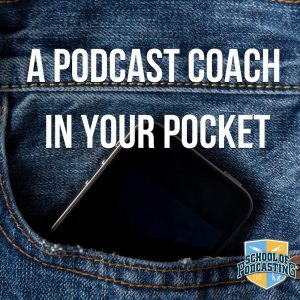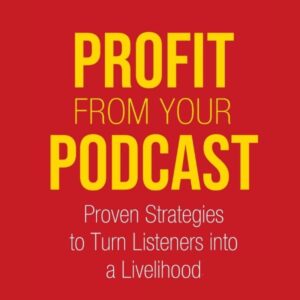
This content may contain affiliate links, meaning I earn a small commission if you purchase through these links at no additional cost to you. I only recommend products or services I trust and believe will provide value to you. Thank you for your support!
You've finished your episode, received feedback (from people not named Mom), and are ready to make it public. You are ready to choose a podcast host. There are so many, and you can feel overwhelmed trying to choose. I thought I would go over the features available so you can see what features resonate with you.
When choosing a podcast host, you should ask yourself, “What does my host need to do?”
FIRST THINGS FIRST
Your show’s popularity has little impact from your media host. If you take a Corvette and put it on an airport runway in Texas, it might go 195mph. If you take that same car and put it on a runway in Iowa, it will still do 195 mph. It’s not the runway; it’s the car. With your show, it’s not the media host; it’s the content, delivery, and promotion. Your host is part of the delivery, but you are responsible for the content (people recommend your show based on the content).
CLEARING THE PODCAST CLUTTER
While Zoom, Squadcast, Riverside, and Descript are all fine tools, they are not podcast hosting companies (they are remote recording and editing tools.
FEATURES I DON’T CARE ABOUT
Features that deliver little value are:
- Audiograms – Flashy? Yes. Effective? No.
- Libsyn’s feeds for destinations – So you??? (helpful in very few cases)
- Automatic social media posting: This sounds cool. However, social platforms have changed their backends and broken this feature a lot over the years. Is it Nice to have? Sure.
It’s about as trustworthy as the milkshake machine at McDonald’s. This has nothing to do with the host and everything to do with Facebook, LinkedIn, etc. - Accepting Donations: Yes, some hosts have this built-in, but do you know Buy Me a Coffee, Paypal, or Venmo? (It's not really a problem, right?)
AVOID FREE MEDIA HOSTS!
Free sounds great, but it’s a horrible business model. Don’t believe me? Ask these podcast hosting companies that used the free model.
- Podshow/Mevio 8/2005 – 4/2014 (116 months – 38.8 million dollars spent)
- Podango 9/2006 – 12/2008 (27 Months)
- wildvoice.com 7/2006 – 7/2009 (36 months)
- mypodcasts.com 2007 – 2011 (estimated 48 months)
- Audiometric.io 11/ 2012 – 8/2014 (21 months before Panoply purchased and removed it from the market)
- Opinion Podcasting 11/2015-10/2017 (23 months)
- Zcat 1/2016 – 1/2019 (36 months)
- Whooshkaa 6/2016-5/2021 (53 months)
- Libsyn Studio 2/2022 – 12/2023 (10 months)
WHY I DON’T RECOMMEND SPOTIFY
Spotify makes things for Spotify (which makes sense). Podcasting is built on an open system, enabling the audience to listen using any app. Spotify sees this differently.
Did they use the Podcasting 2.0 spec when they introduced time stamps? No.
They frequently announce features that sound amazing until you read the fine print. For example, “You can play music in your podcast!!!” Then you read, “You can only listen on the app, not the website, and only in the app if you’re a paying customer, and only after we approve every episode.” Then, a few months later, they discontinued this “feature.”
As a music app, I LOVE THEM, but as a podcast host, they’re a closed garden in an open world.
I know, I know, but it’s free! (Did you not see the list above???). If you must (ughhhh) use free, See Red Circle.
When they quote, “We have XX,XXXX people on our platform,” ask how many are free accounts.
THEY ALL DO THIS – WHAT DOES A PODCAST HOST DO?
They host your files and provide stats and an RSS feed to syndicate to Apple, Spotify, and many others. So when they say, “We help you get in all the directories,” it’s a “duh” statement as that’s what a host does. It’s like a waiter saying, “Hi, I’m Mike. I’ll be your waiter tonight. Not only will I be taking your order, but I’ll also be bringing your food.” Yes, Mike, that’s what a waiter/waitress does.
They also provide stats so you can track your success.
They all provide a basic website.
They should provide a player that is customizable to match YOUR brand (not theirs)
THREE DIFFERENT BUSINESS PLANS
1. Limited Uploads
Many hosts limit the amount of your uploads but have no audience size limits. Notable ones are Buzzsprout, Blubrry , Libsyn, and RSS.com. You have a plan that you can rely on no matter how big you get.
2. Pay More for Downloads
The other business plan allows unlimited shows and episodes. There are no limits, but if you become super popular, your price will go up (theoretically, if you have over 30K downloads, you can monetize and cover the increased cost).
Captivate is $19/month until you exceed 30,000 downloads (Libsyn says the average podcaster gets over 1,100 downloads per episode, and the median (50% get more, 50% get less) is 125 downloads after 45 days. (in September 2024).
Transistor.fm allows 20,000 downloads a month for $19/month
I love the “Pay More for Downloads” plan. 30,000 downloads at Captivate is a hard-to-beat plan, and once you start one podcast, you’ll want a second.
3. The Giving it All Away Plan – Looks Good – But NO!!!
Over the years, a few hosts have tried the business plan of NO limits: as many shows, episodes, and downloads as you want. This means I could start my own media hosting company, use your service, and pay less than $20. Does anybody else see where this is a bad idea? Yes, bandwidth is cheap, but it's not free. And yet, some still try. It only takes one popular show to watch them go out of business.
DYNAMIC CONTENT
Dynamic content allows you to insert a file into your episode. For example, my show dynamically inserts a “Question of the Month,” so listeners of older episodes hear the current month's Question of the Month.
You can (obviously) use this for ads (the most profitable way to monetize a podcast is to sell your products or services). Anything time-sensitive is a great use of dynamic content. For example, as I write this, it is the week before Christmas. If I had a Black Friday sale, I could record one file and add it to the start of every previous episode.
Dynamic Locations
You can dynamically insert content in different places.
- Preroll (before the show starts).
- Postroll (after the episode ends ).
- Midroll (in the episode locations that you pick).
The following hosts have dynamic content.
- Captivate (all of the above and the best dynamic tool)
- Buzzsprout (all of the above)
- Blubrry Pre-Roll for an additional $10
- Transistor’s pro plan ($49) includes all of the above.
- Libsyn and Blubrry offer a “pro” version of their service starting at three figures that include all the above.
Provide Statistics
This is something they all do (or should do). Here are the expected stats:
They all show download stats, audience locations (Libsyn charges for Geographic data), and a 30-day breakdown (Buzzsprout, Libsyn, and Blubrry offer more). To see listener engagement, check Apple Podcasts and Spotify dashboards (never let someone submit your show to Apple “for you,” – like Spotify used to do – or you’ll lose access).
- Downloads: How many downloads are you receiving? If you plan to have advertisers, find an IAB certified.
- Geographic insights: Where is your audience from and listening? This can help if you plan to tour later to see which cities have the most listeners/viewers.Blubrry, Blubrry, Blubrry, and Libsyn ($20 plan) show this information. (It is almost in the “they all do this” category.)
- Comparison stats: Pick one episode and compare it to others. It can help answer, “Is my show growing?”Captivate, Buzzsprout, Blubrry, and Transistor have this stat.
Additional Features
- Transcriptions:
All hosts in this article support transcriptions. Some require you to bring your own (Libsyn), others can make them for a fee (Captivate, Buzzsprout, Blubrry), and others offer them for free (Transistor). - Chapters:
Chapters let the listener jump to different sections of the episode. Libsyn won’t alter your chapters but doesn’t provide tools to create them (so use Hindenburg). Blubrry, Captivate, Buzzsprout, and Transistor let you make and manage chapters.
- Dynamic Show Notes:
Enter something into the host, then add it to your episode description/show notes. You can return to the original notes and change them; they will update all your episodes. Captivate and Buzzsprout and Transistor ($49/level) have this feature.
- Podcasting 2.0 Features:
Podcasting 2.0 aims to enhance functionalities via RSS (and ensure a place for ALL podcasters). New functionality has been added, but it will only be implemented by the app (where people consume the content) if the host implements it in their dashboard.
Blubrry leads with 26 items, followed by RSS.com (15), Captivate (12), Buzzsprout (8), and Libsyn (2). Right now the apps using these features are nowhere near as popular as Apple and Spotify.
- AI Assistance:
These tools help you create episode titles, chapters, summaries, etc. Currently, Captivate($5), Buzzsprout ($10-$20), and Blubrry ($10) have these tools. For all of these hosts, it’s an additional charge (as AI is expensive).
- Selling Ads On Your Show:
Buzzsprout has a marketplace for podcast advertisers to upload their ads, paying $14 per 1000 downloads. You need at least five published episodes that are at least 23 minutes long and a minimum of 1000 downloads in 30 days.Captivate has a tool that allows you to accept money for just about anything and on their website, it states an ad marketplace is coming soon.Blubrry has a plan where you can accept programmatic ads from day one, which pay around $5 per 1000 downloads.RSS.com you need 1000 downloads a month, according to.Libsyn has “Auto ads” for those who get 2000 downloads per month. Again, the payment is around $5 per 1000 downloads.
- Private Podcasts (memberships):
These are great for selling a premium version of your show. Captivate and Buzzsprout have this feature. Both charge more than Supercast, but if you want the convenience of having everything under one roof, they are both fine (with Captivate having a bit more flexibility). Buzzsprout takes 15% with prices of $3, $4, $8, and $10. The listener can choose to pay more if they want. Captivate takes 15%, and you set the price to whatever you want. There is a payment threshold for Captivate??? Blubrry has this feature as part of the $10 bundle I mentioned before and they take 15%.
- Adding Team Members
If you need to add an editor or other team member to your account, they all have this feature except for Libsyn, which only enables it for the “LibsynPro” service. You can always get around this by sharing your password through services like 1Password. Publish to YouTube
Libsyn can convert your audio to a video with a static image, push it to YouTube, and display your YouTube stats in your Libsyn dashboard. Blubrry will post the first two minutes. RSS.com and. Transistor also does have this feature. This feature is in the “better than nothing” field for YouTube. I would recommend doing VIDEO for YouTube.
- Service and Support:
Check their website for a knowledge base and search function. Email support to ask if they support 301 redirects (all listed companies do, but check response time). Some have a status page for recent issues and fix times.
Unique Features
Vid2Pod
If you're a YouTuber wanting to turn your videos into an audio podcast, check out Blubrry‘s Vid2Pod service. It will import your videos and convert them to episodes.
Episode Planning
Captivate has a Chrome extension lets you easily save a website to your Captivate account. You can also jot down notes to use later on the episode.
Erasing Old Baked-In Advertisements
If you previously recorded host-read ads in your show (known as “Baked in,” meaning they’re permanent) in Captivate, you can highlight and replace that part of the episode.
Automatic Volume Leveling and Mastering
For an extra fee, Buzzsprout and Blubrry offer an additional “Mastering” option (Auphonic).
Guest Booking
Captivate has a feature that allows guests to fill out a form that can be added to the episode (This is also on Podpage if you’re not using Captivate).
Text Messages – Buzzsprout customers can receive text messages from their audience
Apps – Buzzsprout has an app to check stats and basic editing. Blubrry has a web to check stats
WordPress Integration
Blubrry is the king of WordPress integration (with Captivate also having a plugin).
Note: If you’re not using WordPress, copy and paste the code to get your player on your site (no big deal) or use Podpage for your website (I work there).
Riverside and Descript Integration
Transistor integrates with Riverside and Descript. Captivate integrates with Descript.
Name Your Pricing Ads
Captivate can receive payments for services, ads, etc., at your price. Other tools take lower fees but for an “all in one place” option. You might check this out.
But who is my favorite?
It depends. None are a terrible choice, but one may fit better due to different features.
My overall favorite is Captivate. Their dynamic tool and AI tools are amazing. Their support is fast and friendly, and they design features to save me time or help me make money.
Buzzsprout is a great choice (and my #2) if you want ease of use combined with more robust features. Their built-in website (while still basic) looks pretty good.
Blubrry is an excellent choice for integrating your show with a WordPress site. Its AI tools will save you time, and it is leading the charge in Podcasting 2.0.
Libsyn has plans that start at $7/month. The oldest media host, you don’t get more solid and reliable (I used to work there). If you want the latest features, they are lagging.





